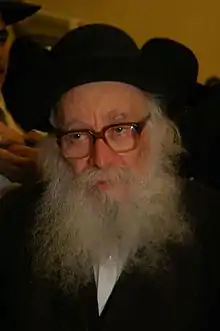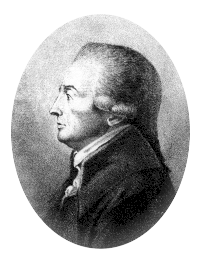Shimshon ben Mordechai of Slonim
Shimshon (Samson) ben Mordechai of Slonim (c. 1734/1736 – 1794), was an 18th-century rabbi, philosopher, mathematician, and scientist. He was one of the leaders of Haskalah and the Misnagdim, and was greatly influenced by the Vilna Gaon. He was the Av Beit Din of Slonim and Königsberg and is thought to have been descended from Shimshon Loew ben Bezalel, the Maharal of Prague's brother through his grandson, Samson ben Pesah Ostropoli.[1]
Rabbi Shimshon ben Mordechai of Slonim | |
|---|---|
| Born | 1734 or 1736 |
| Died | 1794 (aged 59–60) |
| Other names | Samson of Slonim |
| Occupation | Chief Rabbi of Slonim and Königsberg, scientist, astronomer, philosopher, mathematician, and theologian |
| Years active | 1769-1794 |
| Era | 18th-century philosophy |
| Known for | Haskalah Movement, Misnagdim Movement, Approbation of Sefer Oklidus |
| Movement | Haskalah, Misnagdim |
| Opponent(s) | Hasidic Jews |
| Spouse(s) | Basha bat Ze'ev Wolf |
| Children | Gershon Zelig of Kosava |
| Parent(s) |
|
| Family | Karelitz |
Early life and early adulthood (c. 1734-1765)
Not much is known about Shimshon's early life. We do know that he was born in Lithuania, sometime between 1734 and 1736. We also know that sometime at an early age he left for Hamburg to study German, Latin, and Greek, as well as the sciences.[2] After returning from Hamburg around 17 or 18 years of age (1751-1753), and presumably being ordained as a rabbi, he took the job of rabbi in the towns of Kolyshki and Krāslava. He would make many more trips back to Hamburg later in his life, so he could buy books for his collection.[1]
Marriage and life in Slonim (1765-1788)
In around 1765, Ichile Ginshpriker, son of Aryeh Leib Epstein, arranged for his first cousin, Basha bat Ze'ev Wolf and Shimshon to be married. They married on 26 October 1765. In 1769, Shimshon got a seat in Slonim as an Av Beit Din (Chief Rabbinical Judge). He kept this position until around 1791. Shimshon was part of the movement of Haskalah (the Jewish Age of Enlightenment). When he became Av Beit Din in Slonim, he began to spread Haskalah to the whole city. He is regarded as the first to do so in Slonim.
Shimshon's library
He had a library of around 250 to 300 books that he had collected on his journeys to Hamburg and other cities. People such as the Vilna Gaon and Solomon Maimon came to Slonim to borrow books from his library. Among Shimshon's prized possessions was the unpublished work by the rabbi, Joseph Solomon Delmedigo, Bosmat Bat Shelomoh.[1]
Solomon Maimon's visit
In the 1770s, a young Solomon Maimon came from Nyasvizh to visit the library in search of books on science and medicine. According to Maimon, "As soon as I arrived at the place, I went to the chief rabbi, told him my desire, and begged him earnestly for assistance... He promised to lend me some old German books. The most important among these were an old work on Optics, and Sturm's Physics." (likely Johann Christoph Sturm). These books inspired Maimon to find "a key to all secrets of nature" and look down upon others who did not know what he knew.[3]
Meeting with Baruch Schick of Shklov
In 1778, upon the recommendation of the Vilna Gaon, Baruch Schick of Shklov (1744-1808) journeyed to Slonim to ask Shimshon to write an approbation to his Hebrew translation of Euclid's Elements, Sefer Oklidus. Shimshon agreed and wrote part of the introduction to the book. Several other rabbis such as Saul Loewenstamm and Solomon Shalem from The Hague and Amsterdam contributed to the introduction as well.[4] Firstly, he talked about the proper place Euclid had in history. Shimshon assumed that he lived in Greece right around when Mordecai and Esther were living in Persia. Next, he gave a lengthy summary of the contents of the book using his great intelligence and vocabulary. To conclude his writing, Shimshon related it all back to Schick's wish to educate Jews on the sciences. [4] His words followed the same theme that Schick wrote, “Blessed is your logic, and it will bear forth more blessing, for in your book you have refuted the claims our enemies level against us, saying ‘where is your wisdom and your learning in the eyes of the nations?’ Jacob will not be ashamed, for the land will be filled with knowledge, as the waters cover the sea.” [5] Shimshon referred to the Jews being thought of as uneducated and ignorant. Shimshon's intentions were to bring science and mathematics into Jewish people's everyday lives, so they could be recognized as more intelligent. [6]
_-_Approbation.jpg.webp)
Jeremy Bentham's visit
In 1787, the English philosopher, Jeremy Bentham, was going to visit his brother, Samuel in Krichev, when he spent the night in Slonim. As he writes in his journal, all of the inns were full, so he was forced to spend the night with a rabbi who also kept a hardware store. He goes on to describe the rabbi's home and that he had two bookcases with "not fewer than 250 or 300 Vols.". Bentham also talked about how the rabbi possessed a copy of Euclid's Elements as well as a manuscript on astronomy which contained a diagram, that was the rabbi's own work. By piecing together clues, we have been able to figure out that this was the same rabbi who lent Solomon Maimon some books.[7]
The fire, leaving for Königsberg, and death (1788-1794)
Sometime in the late 1780s, after Bentham's visit, a fire started in the thatch roof of Shimshon's house. It eventually consumed everything in his house including all of his books and his own manuscripts. He became stricken with grief. It is said that after the fire, "Shimshon eulogized his loss in the synagogue and cried bitter tears." [8] In 1791, after the fire, he left town for a spot as an Av Beit Din in the town of Königsberg. By that point, Shimshon was sick and very tired. He only served there for a couple years until his passing in 1794.[1]
Descendants
Shimshon's descendants mostly settled in Kosava. They adopted the surname, Karelitz after the town of Karelichy. Some of his most famous rabbinical descendants were the Rabbis Avrohom Yeshaya Karelitz (author of the Chazon Ish), Nissim Karelitz, and Shmaryahu Yosef Chaim Kanievsky. Other descendants include the mathematician Leonard Carlitz, Louis Karelitz, one of the first Jewish settlers in Peabody, Dr. Samuel Karelitz, pediatrician and founding chairman of Long Island Jewish Medical Center (LIJ), Clarence Karelitz, a Massachusetts State Representative, and Jacob Reingold, the vice chairman of the Hebrew Home for the Aged at Riverdale who laid groundwork for the observance of National Grandparents Day in the United States. [9][10]
- Descendants of Shimshon ben Mordechai of Slonim
 Rabbi Avrohom Yeshaya Karelitz (1878-1953) (The Chazon Ish)
Rabbi Avrohom Yeshaya Karelitz (1878-1953) (The Chazon Ish) Rabbi Nissim Karelitz (1926-2019)
Rabbi Nissim Karelitz (1926-2019) Rabbi Shmaryahu Yosef Chaim Kanievsky (1928-)
Rabbi Shmaryahu Yosef Chaim Kanievsky (1928-) Clarence Karelitz (Massachusetts State Representative) (1901-1958)
Clarence Karelitz (Massachusetts State Representative) (1901-1958)
Legacy
All of Shimshon's books and his own manuscripts were destroyed in the aforementioned fire. This unfortunately limits our ability to hear the voice of Shimshon as a scholar. In his family's tradition he was known as "a scholar and Kabbalist, an astronomer and philosopher, accomplished in all seven sciences, the author of many books, on the exoteric and the esoteric, and the chokhmot." [11] Shimshon was also remembered for bringing Haskalah to Slonim as well as being a very ardent Mitnagdim.[8] He also encouraged bringing education into every Jew's everyday lives. He is regarded as being one of the most influential rabbis of Slonim, alongside Moses ben Isaac Judah Lima.[6]
Notable associates
- Shlomo ben Joshua, Solomon Maimon (1753-1800) German philosopher
- Rabbi Elijah ben Solomon Zalman, Vilna Gaon (1720-1797) leader of Mitnagdim and Haskalah
- Rabbi Baruch ben Jacob Schick, Baruch Schick of Shklov (1744-1808) one of the pioneers of Haskalah and author
- Rabbi Aryeh Leib ben Mordechai Epstein of Königsberg, Aryeh Leib Epstein of Königsberg (1708-1775) rabbi and author of Or ha-Shanim
- Rabbi Yitzhak ben Aryeh Leib Epstein, Ichile Ginshpriker of Slonim (1730-1807) Basha (Shimshon's wife's) first cousin. Son of Rabbi Aryeh Leib Epstein of Königsberg
See also
- Getzel Kressel (1911-1986) Israeli author
- Samuel Joseph Fuenn (1818-1891) Russian scholar
- Menachem Mendel Frankfurter (1742-1823) founder of the Talmud Torah in Hamburg and grandfather of Samson Raphael Hirsch
- Eliezer Segal (1950–present) Canadian professor
- Rabbi Ephraim ben Shlomo Zalman Epstein of Vilna rabbi and author of Gevurot ha-Ari. Great-grandson of Rabbi Aryeh Leib Epstein of Königsberg
- Kalman Lichtenstein (born 1899) author of Pinkas Slonim (Memorial book of Slonim)
References
- Lichtenstein, Kalman (1961). Pinkas Slonim [Memorial Book of Slonim]. 1. Tel Aviv: Irgun ʻole Slonim be-Yiśraʼel. pp. 33–39.
- Shuchat, B. Raphael (1998). The Debate Over Secular Studies Among the Disciples of the Vilna Gaon. 8. Torah U-Madda Journal. p. 287.
- Maimon, Solomon (2019). The Autobiography of Solomon Maimon: The Complete Translation. Princeton University Press. pp. 107–108. ISBN 978-0691163857.
- Zwiep, Irene (2008). Sepharad in Ashkenaz: Medieval Knowledge and Eighteenth-Century Enlightened Jewish Discourse. Edita. pp. 300–301. ISBN 978-9069844824.
- Feiner, Shmuel (2002). Seductive Science and the Emergence of the Secular Jewish Intellectual. United Kingdom: Cambridge University Press. p. 129.
- Segal, Eliezer (2015). "Non-Euclidean Theocracy". Chronicles and Commentaries: More Explorations of Jewish Life and Learning. Quid Pro Books. ISBN 9781610278232.
- Bartal, Israel (2013). "Jeremy Bentham and Samson of Slonim: Two Book Lovers' Story". A Touch of Grace: Studies in Ashkenazi Culture, Woman's History, and the Languages of the Jews Presented to Chava Turniansky. Jerusalem: Shazar. pp. 215, 221–226.
- Macdowell, Mississippi Fred (2011-06-13). "On the Main Line: Some notes about the Vilna Gaon's librarian, or, Math is fun". On the Main Line. Retrieved 2019-11-29.
- "Karelitz - Korelitz - Karelis Family Home Page". www.karelitzfamily.com. Retrieved 2020-08-17.
- Pace, Eric (1999-02-05). "Jacob Reingold Is Dead at 83; Leader in Caring for Elderly". The New York Times. ISSN 0362-4331. Retrieved 2020-08-22.
- Feiner, Shmuel (2011). The Jewish Enlightenment. United States: University of Penn Press. pp. 24–25. ISBN 978-0812221725.
Further reading
- Zinberg, Israel (1988), Italian Jewry in the Renaissance Era. Ktav Pub Inc. p. 174.
- Nadler, Allan (1997) The Faith of the Mithnagdim: Rabbinic Responses to Hasidic Rapture. Johns Hopkins University Press. p. 137.
External links
- https://kehilalinks.jewishgen.org/slonim/Ledger.html
- http://www.karelitzfamily.com/ Family tree of Shimshon's descendants
- https://people.ucalgary.ca/~elsegal/Shokel/130607_Euclid.html
